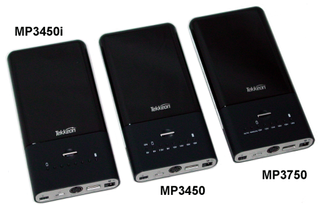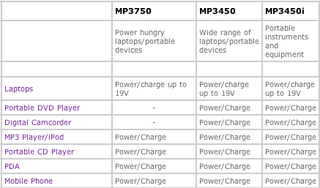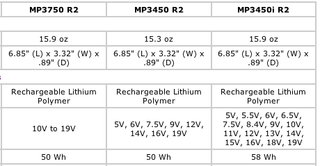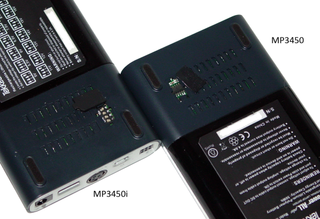External Battery Roundup: Stay Away From The Wall Socket
Tekkeon myPower ALL Plus MP3750, MP3450, MP3450i

The last three batteries in our roundup come from Tekkeon. While the company offers many portable power solutions, these are the only products that can be used to power your notebook.

The myPower batteries aren’t really designed to take a lot of abuse. Their ABS plastic cases aren't thin, but they will crack if you drop them on a hard surface. More annoyingly, these are the only batteries in the roundup (besides those from Energizer) that use a high-gloss black piano finish. I’m not against this type of design, but it isn't very suitable for high-mobility devices.
The bottom half of the battery is matte to begin with, so it wouldn’t be too much of a stretch to use that motif for the whole design.

The purposes of these three batteries can be a bit confusing. All of them are suitable for use with notebooks. There isn’t a netbook- or notebook-specific model, but the MP3750 is the only one that comes with the tips necessary for use with full-sized notebooks like the Vostro 3300 and ThinkPad T510. For that reason, we exclude the MP3450 and MP3450i from our notebook battery test.

The MP3450 and MP3450i can also be used with notebooks, but their compatibility lists are shorter. Instead, those two models are better suited to portable DVD players and digital cameras.

The MP3450i, in particular, allows more granular control through the use of DIP switches. This is a feature you won’t see on the MP3450 or MP3750. Moreover, voltages listed in the table only apply to voltages supported through the output cable. All three batteries still output 5 V through the USB port.



All three batteries have eight LEDs, and the first indicates On/Off status. The MP3750 employs a different design than the other two, though. When you plug a tip into the connected output cable, the battery has no off status. Instead, it is either in a manual or auto voltage selection mode. The MP3750's second LED indicates whether you are in manual mode, while the first indicates auto. It is the only battery to feature an auto-selection mode.
Stay on the Cutting Edge
Join the experts who read Tom's Hardware for the inside track on enthusiast PC tech news — and have for over 25 years. We'll send breaking news and in-depth reviews of CPUs, GPUs, AI, maker hardware and more straight to your inbox.
Choosing this option causes the battery to use a sense resistor to ratchet up voltage until the notebook starts to draw power. Once that occurs, the battery locks in the voltage. In manual mode, you need to cycle to the correct voltage using the button above the LEDs before you hook the external battery to your notebook.
Current page: Tekkeon myPower ALL Plus MP3750, MP3450, MP3450i
Prev Page PowerTraveller PowerGorilla And MiniGorilla Next Page MikeGyver: The Mac Solution-
lashabane Excellent article. I had an idea that this stuff was out there but never really bothered to look. If the 4-5 hours I get from my Asus 1215t begins to not cut it, I now know where to look. Thanks!Reply -
zodiacfml I did not understood any of the technical reading especially the part about the desktop PSU.Reply
At one point, it is stated that AC adapters have higher voltage than the battery on a notebook so that it can be charged. Then, how can a external battery damage a notebook's electronics with a higher voltage (only if it's too high)?
It is not stated how to set the external battery voltage correctly. What then is the correct voltage? Correct me but I believe the voltage has to be equal that of notebook battery.
-
burnley14 It's pretty remarkable that after page 2 I could guess who the author of this article was (without looking of course) due to the thoroughness and good grammar/lack of typos. Hats off to you yet again, Mr. Ku. Job well done as always.Reply -
nukemaster zodiacfmlI did not understood any of the technical reading especially the part about the desktop PSU.At one point, it is stated that AC adapters have higher voltage than the battery on a notebook so that it can be charged. Then, how can a external battery damage a notebook's electronics with a higher voltage (only if it's too high)? It is not stated how to set the external battery voltage correctly. What then is the correct voltage? Correct me but I believe the voltage has to be equal that of notebook battery.Your guess is actually right. The battery with its voltage set too high can damage the notebook.Reply
If you need to know the voltage required, you just check on your laptop AC adapter or power brick. It is not always the same as the battery.
For instance, a Compaq R3000 has an 18.5 volt AC->DC(120w) power supply and its battery is only 14.5 volts. The voltage regulators in the laptop(in the charging system) it self cut it down to the needed 14.5-15volts to charge the battery.
Also note that the AC adapter does NOT spit out AC it in fact spits out DC(it has a rectifier to convert AC to DC).
As you can see by this picture(you have to click the link), The adapter takes in AC 120V and spits out DC 18.5V. AC is shown with a ~ and DC with a --_---_-- cant make it on here, but you get the point.
http://img269.imageshack.us/img269/1950/powerw.jpg -
Luscious Quite a different experience on my end testing the Energizer XP8000 and XP18000.Reply
For my smartphone and MiFi, the XP8000 just can't be beat. 5x runtime guarantees me 20+ hours of 3G broadband and week-long phone use. Being barely bigger than a Blackberry, I can effortlessly stash the XP8000 on my belt, and charge my smartphone while I walk.
The XP18000, on the other hand, was a huge disappointment. Using a Toshiba NB305 netbook, it was incapable of recharging the factory 6-cell battery while powered on, and could not provide 2 full charges while powered off. For my usage scenario, that's a failure, as I plug in the external battery when my netbook hits 3% critical, right before Windows does a force shutdown, allowing me to continue working.
Using this deplete-charge-deplete approach SHOULD allow me 14+ hours of continuous power-on time, except that even the beefy XP18000 couldn't get through 1 netbook charge. Had it been capable of providing one full charge powered on, or two full charges powered off, I would have recommended the XP18000 as well.
http://lgponthemove.blogspot.com/2010/07/accessory-corner-3-energizer-xp18000.html -
a_fortiori Nice article. I wonder if these units can be used as a mini-ups for equipment like a NAS, routers and modems. It would be great if you could wire these with the NAS, and be sure that a power outage wouldn't damage the NAS. Considering that the NAS units typically consume much less power than a notebook, these should be able to cover 4-5 hrs of power outage (?) Any thoughts?Reply -
junixophobia shineon2010Very good info , alot of products that im having second thoughts about.Reply
Just buy an automatic inverter that works for hours with a car battery
Most Popular

